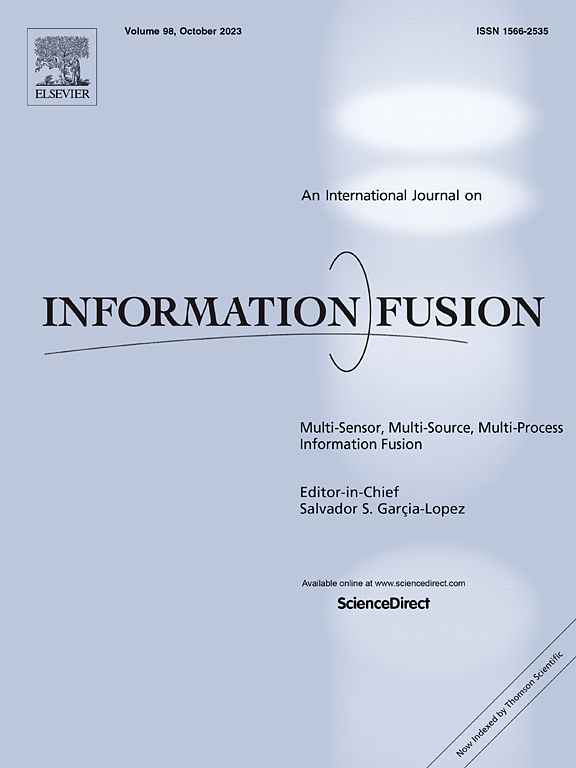Dynamic decision-making paradigm for multi-modal information in a human–computer interaction perspective: Fusing composite rough set and incremental learning
IF 14.7
1区 计算机科学
Q1 COMPUTER SCIENCE, ARTIFICIAL INTELLIGENCE
引用次数: 0
Abstract
The knowledge contained in different modal information and their perspectives on the description of specific objects are different. With the development of data science and computer technology, uncertain decision-making with multi-modal, nonlinear, unbalanced, and incomplete characteristics has become a trend, posing a great challenge to traditional uncertain decision-making methods. In view of this, this paper proposes a dynamic decision-making paradigm for multi-modal information by fusing composite rough set and machine learning under the perspective of human–computer interaction. First, a multi-modal hybrid attribute information system (MHAIS) is constructed for incomplete multi-modal hybrid attribute information in numerical, textual and image modals, and several degradation scenarios of MHAIS are discussed. Second, to achieve multi-modal information fusion and reduce redundant attributes, multi-modal hybrid binary relationships are constructed for numerical, textual and image modals in MHAIS, and multi-modal composite rough set and its attribute reduction method is given. Then, uncertainty decision-making models conforming to different realistic decision-making situations are established from the perspectives of three multi-modal information fusion strategies, namely feature-level fusion, model-level fusion and decision-level fusion, respectively. Finally, the above process is extended to the dynamic decision-making process, and the corresponding incremental learning paradigm is given. An example study using real datasets of rheumatoid arthritis patients from Guangdong Provincial Hospital of Traditional Chinese Medicine and 10 public datasets is carried out in this paper to verify the scientific and superiority of the proposed method. On the one hand, this paper introduces the idea of human–computer interaction and different strategies of multi-modal information fusion into realistic uncertain decision-making problems, and on the other hand, it makes a new contribution of the integration of rough set theory and machine learning in the development of management science, decision science and computer science.
人机交互视角下多模态信息的动态决策范式:融合复合粗糙集和增量学习
不同的模态信息所包含的知识及其对具体对象的描述视角是不同的。随着数据科学和计算机技术的发展,具有多模态、非线性、不平衡和不完全特征的不确定决策已成为一种趋势,对传统的不确定决策方法提出了巨大的挑战。鉴于此,本文提出了一种人机交互视角下融合复合粗糙集和机器学习的多模态信息动态决策范式。首先,针对数字、文本和图像三种模式的不完全多模态混合属性信息,构建了多模态混合属性信息系统(MHAIS),并讨论了MHAIS的几种退化情况。其次,为实现多模态信息融合,减少冗余属性,在MHAIS中构建了数值、文本和图像模态的多模态混合二元关系,给出了多模态复合粗糙集及其属性约简方法;然后,分别从特征级融合、模型级融合和决策级融合三种多模态信息融合策略的角度,建立了符合不同现实决策情境的不确定性决策模型。最后,将上述过程推广到动态决策过程,并给出了相应的增量学习范式。本文利用广东省中医院类风湿性关节炎患者的真实数据集和10个公开数据集进行了实例研究,验证了所提出方法的科学性和优越性。本文一方面将人机交互的思想和多模态信息融合的不同策略引入到现实的不确定决策问题中,另一方面,将粗糙集理论与机器学习相结合,为管理科学、决策科学和计算机科学的发展做出了新的贡献。
本文章由计算机程序翻译,如有差异,请以英文原文为准。
求助全文
约1分钟内获得全文
求助全文
来源期刊

Information Fusion
工程技术-计算机:理论方法
CiteScore
33.20
自引率
4.30%
发文量
161
审稿时长
7.9 months
期刊介绍:
Information Fusion serves as a central platform for showcasing advancements in multi-sensor, multi-source, multi-process information fusion, fostering collaboration among diverse disciplines driving its progress. It is the leading outlet for sharing research and development in this field, focusing on architectures, algorithms, and applications. Papers dealing with fundamental theoretical analyses as well as those demonstrating their application to real-world problems will be welcome.
 求助内容:
求助内容: 应助结果提醒方式:
应助结果提醒方式:


